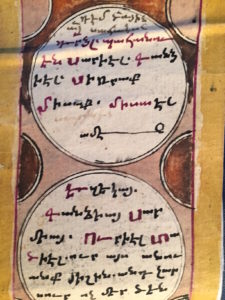Hmayil scrolls were used by our Armenian ancestors for many purposes. In a time before penicillin (pre-1929), how would you care for your sick loved ones? Or, how would you protect your relatives who were traveling in rough areas of the country? What tangible effect could you offer your loved ones? Personal Hmayil scrolls were created for families to serve that purpose. They were laid next to the sick person, the prayers and Gospel readings were read and offered up to God. In some cases they were passed down from generation with the benefactors’ names added. These were usually written by monks, but were not controlled or distributed by the Church. The scrolls contain prayers, painted images from the Gospels, Church Saints, allegorical figures as well as petitions for healing and safe travel. This particular manuscript also has written script which is unreadable. An Armenian Priest, Father Daron from Detroit has explained that this is a secret script meant to hide a special meaning.
Archivist Anahit Campbell
Recently, I had the wonderful opportunity to work with Anahit Cambell on a conservation of an old Hmayil scroll manuscript. She comes with worldwide training and experience, including at the Matenadaran Manuscript Archive in Yerevan, Armenia.
Hmayil Scroll, 144 inches, 1827, possibly from Istanbul
Note above, the lines above the dates reveal the date
The scroll I am showing was created in 1827, and has a number of issues. First and foremost, someone glued a piece of paper to various parts of the scroll to hold it together. These are not acid free materials, and over time will cause problems and harm to the manuscript. The manuscript also has dirt, tears and wrinkles.
Please do not attempt to restore these scrolls on your own, consult an expert to save a preserve these treasures. Damage can be done to these manuscripts if water, chemicals, etc. are not used by an expert. Anahit’s email is listed below.
The following steps will be used when conserving an ancient or near ancient manuscript:
1. Document the manuscript.
Take pictures, measure it, record all information about it, where it came, how old is it, who were the writers, painters, etc..
2. Clean the manuscript.
This is done very carefully working with millimeters of space. Test with water and chemical vapor-soaked cotton.
3. Test and Analyze the manuscript.
Inspect for harmful chemicals, stains etc. Note non-archival white lined paper. This paper was placed by some unknown person at an unknown date.
4. Remove chemicals, tape, glue, etc.
A fine focused steam can be used to soften the glue. Ideally, the tape and glue should come off in one piece.
5. Flatten out the wrinkles in the manuscript.
These wrinkles can cause issues in the future, and can be flattened with very small amounts of water (after testing solubility) or by use of an alcohol pen.
6. Fill in tears, holes and mend broken pieces with Japanese tissue paper.
Japanese paper is made with long acid free fibers. An acid free wheat glue will be used to attach the tissue paper to the manuscript.
7. Fix tears at folds in the manuscript.
By gently wetting the manuscript, the crease can be refolded. Then absorbent paper is used to blot excess moisture on the sides. Japanese tissue paper is used to fix the tear.
8. Display the manuscript.
Show off the fruits of your labor.
Anahit is a true expert and is available to answer questions. She has kindly allowed us to publish her learned techniques on the ANAS and ANAS Facebook. Conservation service inquiries can be directed to her e-mail: [email protected]
More about Anahit Campbell
Anahit Campbell is from Milwaukee, Wisconsin and is a graduate student in analytical chemistry at the University of Wisconsin – Milwaukee. She holds a B.A. in art history and B.S. in chemistry both from the University of Wisconsin – Milwaukee and a Graduate Diploma in Book Conservation from West Dean College (UK). Her interests are in Armenian manuscripts and analytical techniques. She has gained experience at the Matenadaran Manuscript Archive (Yerevan, Armenia), the Buffalo Bill Center of the West (Cody, Wyoming), and the Milwaukee Art Museum (Milwaukee, Wisconsin). Anahit is currently a co-chair of the American Institute of Conservation’s LCCDG Book and Paper Discussion Group.
STEPS OF RESTORATION:
After researching methods for removing glue and repair paper that is non-archival. Anahit contacted the Matenadaran Manuscript Museum of Yerevan Armenia. It was decided to use a Methyl Cellulose paste. This is made by using Methyl Cellulose powder and boiling distilled water mixed together. The ratio is 8/1. The paste is placed on the paper which is to be removed. Timing is important as the water mix is held in place by the thick paste and it is meant to soften the the glue and paper. A thin spatula is placed almost parallel and pressure is applied to lift the paper and glue together. We do not want the moisture to penetrate the manuscript as the writings and images are water color based. Also, care must be taken not to tear the manuscript.  methyl cellulose and distilled water mix
methyl cellulose and distilled water mix
There were about 13 tears and folds. A few were torn completely through. We were able to remove all of the old paper and most of the old glue. It is believed that the glue was an acid free wheat glue. We will use archival papers to re glue this manuscript together. Look for the post soon.
note photo below showing the gentle teasing of the old glue and paper off. 
-
Chuck Hajinian







